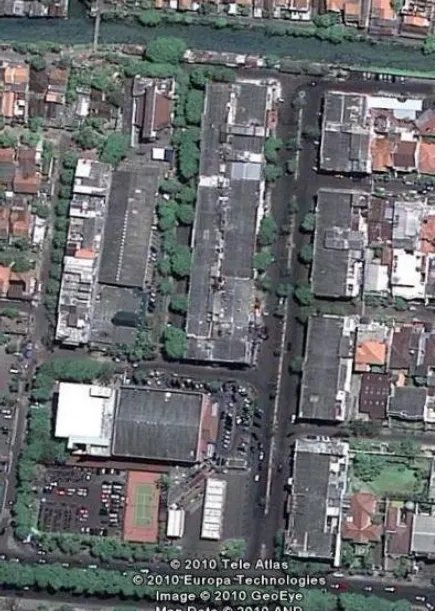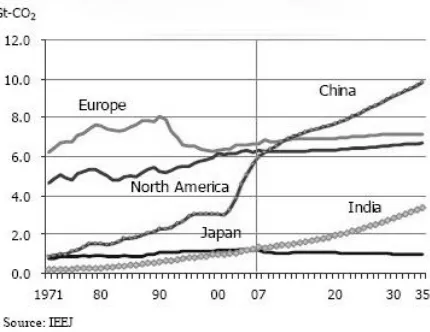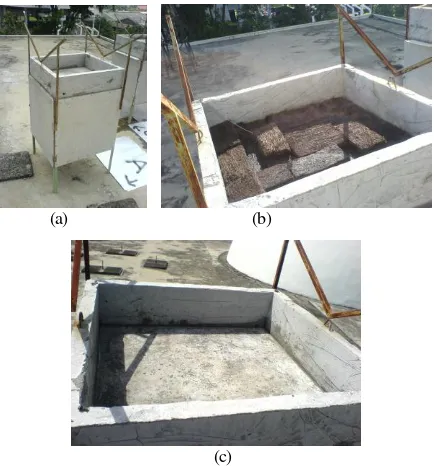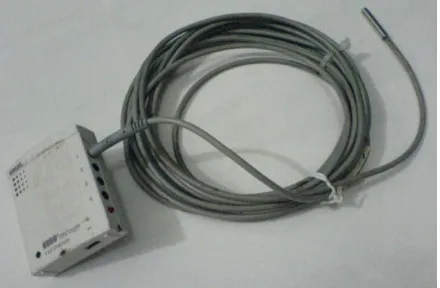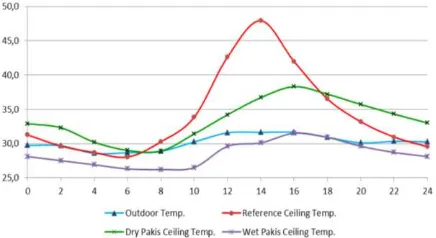PRIMARY STAGE OF PAKIS-STEM-BLOCK SYSTEM AS THERMAL
PROTECTIVE TO FLAT BARE CONCRETE ROOFTOP IN TROPICAL
CLIMATE OF SURABAYA
Danny Santoso Mintorogo1, Mohd. Hamdan Ahmad2
1)
Department of Architecture, Tropical Housing Studies, Petra Christian University, Surabaya, Indonesia 60235.
Email: dannysm@peter.petra.ac.id 2)
Institute Sultan Iskandar, Universiti Teknologi Malaysia, Johor Bahru, Malaysia. Email: b-hamdan@utm.my
ABSTRACT
In the era of global warming and increasing urban heat island condition, flat concrete deck on shop-houses may be less sustainable to handle the excessive solar heat radiation impacts on the roof surfaces. Innovative alternative roofing system is needed to manage heat radiation that will lead to sustainable factors likes energy savings, less energy body used on the roofing materials, and provide comprehensive environmental friendly roof system. This paper discusses about particular
environmental friendly materials such as ―Pakis-Stem Blocks‖ system is a good thermal resistant to absorb the solar sun heat and provide natural cooling through convective-wind without adding substantial loads to the roof structures. ―Pakis-stem
blocks‖ are easier, cheaper and more valuable than other sub-structure roofing materials as thermal resistant layer on flat bare concrete deck besides green roofing systems.
Keywords: Flat bare concrete roof, pakis-stem blocks, thermal protective.
INTRODUCTION
From 20th to 21th centuries in Indonesia, com-mercial buildings, some residential housings, multi-family dwellings, shop-offices, and shop-houses have been commonly built with rooftop concrete flat roof-ing for easy of expandroof-ing spaces in the future. The concrete flat decking rooftop systems are simple; the reinforced concrete rooftop structures are around 120 mm to 200 mm. The rooftop flat concrete decks are mostly built without outer and inner layers of insula-tion and no special thermal sheet barrier covers likes asphalt roll, thermoplastic polymer, single-ply mem-brane, and cool roofing coatings. The surface thermal performance of concrete rooftop flat deck in hot and humid tropical climate of dry season in late July during the daytime (6 am to 6 pm) has an average of 38.6oC and concrete surface deck temperature during the nighttime (6 pm to 6 am) is average of 31.8oC. The peak concrete surface decking temperature is 54.8oC at 12.20 pm.
Figure 1 and Figure 2 show the flat rooftop con-crete decks on shop-houses at two commercial zones, most shop-houses have been entirely operated with air conditioning systems, and those two-story shop-houses are fully functioned as commercial spaces likes restaurants, offices, and stores. Figures 1 (commercial zones at Manyar Kertoarjo street) has around 10,100 square meters of rooftop concrete decks; other
com-mercial shop-houses at Galaxy street have nearby 12,400 square meters (Figure 2).
Figure2. Rooftop Concrete of 12,400 m2 (Author, 2010)
The total average of 12 hours of heat solar irradiation on horizontal surface per day during July month has an average of 400 Wh.m-2. Meanwhile, maximum hourly horizontal solar irradiance can reach to 900 to 1,000 W.m-2 (Mintorogo, 2008).
The concrete rooftop flat decks are mostly dominated built than metal or steel rooftop decks. Table 1 shows that reinforced concrete structures have lower production energy materials than metal (Alsamsam et al. 2009). This could help leading to sustainable concrete structure.
Global Warming Aspects
Global warming is the process of rising of the average atmospheric temperature, earth-temperature, sea-level, and greenhouse gases such as carbon dioxide, water, and hydrocarbon. The concentration of the atmospheric of CO2 will has risen the earth temperature and causing the global warming of the air temperature. Some political science leaders said that the global warming can be a myth, because the evident of rising of the carbon dioxide and tem-perature in the atmosphere has been happening from the past 3000 till 50 years (Robison et al. 1997). Robinson also stated that carbon dioxide and hydrocarbon in the atmosphere actually did not harm all creatures in the earth, yet those CO2 and HC play a major role for accelerating the growth rates of plants and the growth endeavour in drier region
environ-mental. According to COP-15 conference results that are struggling to set out the post-Kyoto Protocol framework (limiting world greenhouse gases emission to slow the progress of global warming), China is already the world largest CO2 emitter than the United States in 2007 and will overtake the entire European continent around 2013 (Kanekiyo, K. 2010). Figure 3, Kanekiyo shows the world CO2 emissions taken from IEEJ (The Institute of Energy Economic, Japan); China will become the leader of not only producing coals but producing also CO2 till year 2035. Indonesia now is the third largest in the world for producing the CO2 emission due to the deforestation (Murray, I. 2008, http://www.mongabay.com 2007).
The world atmospheric temperature has already soared to around 0.6oC with linking to global warming; meanwhile mean annual temperature has increased by about 0.3oC in Indonesia (Hulme, M. et al. 1999, Boer et al. 2004). In addition to the risen of world atmospheric temperature, the earth temperature has also escalated to 0.74% or +- 0.18oC for 100 year decade http://id.wikipedia.org/wiki/Pemanasan_global).
Figure 3. The World Carbon Dioxide Emissions (Kanekiyo, 2010)
Sustainable Aspects
it will reflect the solar spectrum and heat of the sun back to the atmosphere. A typical solar reflectance of at least 0.3 on concrete will correspond to a solar reflectance index (SRI) of 29. Thus creating a very reflective concrete (by painting white or putting white cement on concrete) will obtain a SRI of 78. Concrete has less CO2 in terms of producing Portland cement; it embodied around 100 to 300 Kg of CO2 in an every cubic meter of concrete, besides concrete will reabsorb the CO2 in the air through a process called carbonation during the product life cycle. 1 m3 of concrete weighs approximately 2400 Kg. A research showed on table 1 that reinforced concrete as building structure and rooftop flat deck will only need 2.5 GJ/t of energy production of extracting, transporting, and manufacturing raw materials into building materials than building material for steel structure of 30 GJ/t. Table 1 shows the embodied energy production for concrete and other common building materials; reinforced concrete rooftop flat deck is going to be a sustainable building materials in terms of its low embodied energy used for rooftop.
Table 1. Embodied Energy for Various Building Materials
Problem Statement
Because most of the concrete rooftop flat deck at commercial buildings, and shophouses are built with bare flat reinforced concrete materials, the cooling loads due to intent high heat solar radiation on horizontal surface will burden the use of air conditioning that leads to a un-energy saving domain.
GOALS OF RESEARCH
In reponding to sustainable architectural design schemes, world’s global warming aspects, and users friendly environment materials for energy savings in cooling loads due to common use of bare concrete flat deck rooftop on shophouses and commercial roofs, this research seeks the right friendly environmental materialsPakis/Picasstemblocks as outer heat barrier
to covering over the existed rooftop concrete flat deck -that minimize the cooling loads in tropical hot and humid climate of Surabaya.
LITERATURE REVIEWS
Types of flat roof systems are commonly used throghout the United States and other countries. The common base structural roof is flat concrete deck and will be covered with varities of roof membrane materials. Several factors to be concerned are their durability and cost; the flat roofs are roll asphalt, aingle-ply membrane, multiple-ply, and flat-seamed metal and vegetated roofs.
Asphalt Roll Roofing
Used since year 1890 till now, asphalt sheet roll which consist of one layer of asphalt-saturated organic or fiberglass base felts. Asphalt roll mem-brane is applied by nails and cold asphalt cement, and sometime covered with granular mineral over top of asphalt membrane; the membrane could last around 10 years.
Single-ply Membrane Roofing
These singleply roofing membranes commonly used are thermoset, thermoplastic, or modified bitu-men. Those membranes are less expensive to install, durable, lighter in weight, and produced in two colorswhite and black. Singleply membrane lasts 10 to 20 years, and the newest singleply membranes are made with selfcleaning and moldresistant polymers to maintain solar reflectance. The leader famous single-ply membranes used is EPDM (ethylene propylene diene terpolymer; EPDM is a rubber roofing membrane, and it has last about 25 years in the market. TPO (thermoplastic polyolefin) white or black membrane is a blend of polymers which could contain or not the desirable additives of UV absorbers. TPO could last around 30 years and is largely maintenance free product. Other products roofing membrane are PVCa synthetic thermoplastic polymer; it is the most expensive of the three products but it has excellent durability on longterm performance.
PAKISSTEMBLOCKS
has diameter roughly 200 to 400 mm, and very porosity. The stems then are sliced to pieces of stem-blocks with dimension of 260 mm length, 130 mm width, and 30 mm thick. Figure 4 (a to c) gives a closer look to the Picas trees and sliced block. Those pakis stems or blocks are widely use as interior decoration materials and sliced pakis stem blocks have been consumed by orchid users and are sold in flower stores.
(a)
(b)
(c)
Figure 4. Pakis ―Picas‖ trees in the forest (a) and (b), sliced
Pakis-stem-block (c), (author, 2010)
METHODOLOGY
Research on gathering the sustainable rooftop flat concrete thermal performance for savings energy on cooling loads is dealing with two model; one is for reference model, and the other model is covering with organic Picasstemblock. Each model is measured its thermal performance for 6 days continuously and simultaneously. There will be twosystem measure-ments; one measurement is dry Pakisstem-block, and others is wet Pakisstemblock. With wet mode, the Pakisstemblocks are sprayed two times per day; that is at 6 am and 12 noon. All test models are in closed mode systemno ventilation opening; just having infiltration through door and walls.
Models Testing
The models have dimension of 1000 wide x 1000 length x 1000 mm height. The floor is lifted 500 mm distance from ground. The rooftop flat concrete flat deck of 800 mm thick is 1000 wide x 1000 length x 400 mm height. The walls are of portland cement (kalsi) boards of 40 mm thick. The walls and floor are covered with 200 mm foam boards as interior surfaces. No horizontal shading device and styrofoam stick on the exterior 4side walls (natural mode). Figure 5 descrebes the model reference (a) and one layer Picas-stem covered model (b); one layer of Picasstemblock of 1 square meter has 27 blocks. The total weight of dry Picasstemblock of 1 m2 is 6 kilo-gram, meanwhile the wet Picasstemblock on 1 m2 weigh up 9 kg.
(a) (b)
(c)
Equipment
The measuring equipment is one piece of HOBO U15 with four external data logger water/soil temperature sensors. 1 sensor is connected to Pakis-stem-block; and other one sensor is clinged to concrete surface. Another 1 sensor is sticked to the internal concrete model; and the rest is for the interior temperature. Figure 6 shows the HOBO U family has a mesurement range of temperature from -20oC to 70oC; Rh is 5% to 95%. The external input channels have a 0 to 2.5 DC volts; and the mesurement range is -40oC to 50oC in water, while it ranges -40oC to 100oC in air.
Figure 6. HOBO U Family Data Logger and External Water or Soil Sensor, (author, 2010)
RESULTS
The concrete surface temperature at reference model has an average of 35.9oC; meanwhile the maximum surface temperature can reache to 52oC at noon, and the lowest temperature is 27.9oC at 6 am. The inner concrete ceiling surface temperature reaches an average of 34.2oC, and the highest tem-perature is 47.9oC at 2 pm. The lowest inner ceiling concrete reference model temperature is 28oC at 6 am (figure 7).
Figure 8 describes the thermal performance flat concrete rooftop model with completely dry Pakis-stem-blocks covered over the flat concrete deck. The average of dry Pakis-stem-block temperature is 32.7oC. The maximum dry Pakis-stem-block temperature at noon is 34.4oC, outdoor of 31.6oC, concrete surface temperature of 36.7oC at 4 pm, inner ceiling concrete temperature of 38.3oC at 2 pm, and the room tem-perature of 39.7oC at 4 pm. The lowest dry Pakis temperature at 6 am is 28.2oC, outdoor temperature of 28.7oC, dry concrete surface temperature of 29.2oC, inner concrete ceiling temperature of 29.0oC, and the room temperature of 26.5oC.
Figure 7. Reference Model Thermal Performance
Figure 8. Dry Pakis-Stem-Blocks Model Thermal Performance
In the meantime, figure 9 shows the wet Pakis-stem-blocks thermal performance. All lowest thermal temperatures are happended as usualy at 6 am; the outdoor shaded temperature, wet pakis-stem-block, rooftop flat concrete surface, inner concrete ceiling, and room temperatures respectively as 28.7oC, 24.9oC, 25.6oC, 26.3oC, and 26.0oC. With wet Pakis-stem-blocks covered, the rooftop concrete surface temperature is lower 3.6oC than covered with dry pakis-sblocks. The rooftop surface concrete tem-perature difference at peak (4 pm) is 6.8oC with wet pakis-stem-cloks covered than with dry ones. The maximum wet Pakis-stem-bloks temperature happended at 2 pm is 29.0oC; the outter flat rooftop concrete surface temperature happended at 2 pm of 30.1oC, room temperature of 31.1oC. The concrete ceilling temperature is highest at 4 pm of 31.5oC. The average temperature of wet pakis-stem, outter surface concrete rooftop, inner concrete ceiling, and room model respectively as follows: 27.1oC, 27.9oC, 28.5oC, and 29.0oC.
pakis-stem-block covered flat concrete surface temperatures are respectively of 33.0oC and 27.9oC. So the average temperatures difference are 2.9oC for dry Pakis-stem-block covered; and 8.0oC for the wet Pakis-sblocks concrete surface covered. The maximum tem-peratures at noon of flat bare concrete rooftop, dry-stem-blocks covered, wet Pakis-stem Blocks concrete rooftop covered are 52.0oC, 33.2oC and 28.9oC res-pectively.
Figure 9. Wet Pakis-Stem-Blocks Thermal Performance.
Figure 10. Surface Concrete Temperature Differences of Reference model, Dry and Wet Pakis-Stem-Blocks Covered
Figure 11. The Ceiling Concrete Temperatures of Reference model, Dry and Wet Pakis-Stem-Blocks
Let’s see the figure 11, the average inner con-crete ceiling temperatures of the reference, dry and wet Pakis-stem-blocks model are 34.2oC, 33.4oC, and 28.5oC respectively. The highest ceiling temperatures of the three models occored at 4 pm. The reference model has the maximum temperature of 47.9oC at 2 pm, while the dry Pakis-stem-blocks concrete ceiling
temperature is 36.7oC at 2 pm, and the wet Pakis-stem-blocks concrete ceiling temperature is 30.1oC at 4 pm. The thermal heat conduction from solar heat radiation impacted on flat concrete rooftop could be reduced significantly about 11.2oC if it covers with dry Pakis-stem blocks and about 17.8oC with wet Pakis-stem blocks.
Observed the figure 12, the room temperature of the reference model is higher than dry and wet-stem-blocks systems. The room temperature of those modified organic roofing systems are higher from 6 am to 10 pm than outdoor temperature, this pheno-menon are due to closed mode passive system— infiltration only. Figure 12 demonstrates those organic material on rooftop of flat concrete could reduce the heat of solar irradiation that impacted during daytime (from 11 am to midnight). The average of room temperature covered with dry-stem-blocks is 31.6oC. Covered with wet-stem-blocks save only 0.6o compare to dry system. Meanwhile the average reference room temperature is 33oC, and the shaded outdoor tempe-rature is 30.2oC on July month. The maximum room temperature at noon at reference model is 40.3oC, and the model covered with dry-stem-blocks is 36.6oC. The wet-stem-blocks model is 32.4oC. Meanwhile the outdoor temperature at 6 am is 28.7oC, the lowest room temperature for reference, dry, and wet-stem-blocks model are of 28.3oC, 26.5oC, 26oC respectively.
Figure 12. The Room Temperature of Reference model, Dry and Wet Pakis-Stem-Blocks
CONCLUSION
flux through rooftop concrete only, horizontal shading devices and wall insulations have to be installed on models.
Acknowledgement
I gratefully thank to Prof. Mohd. Hamdan for his great support to make this paper done. Also thanks to the department of architecture, tropical housing studies laboratory for providing equipment for measurements.
REFERENCE
Alsamsam, I., Lionel L., Martha G.V.G. (2009).
Sus-tainable High Performance Concrete Buildings,
Illinois
Boer, R., A. Faqih, (2004). Current and Future Rainfall Variability in Indonesia. In An Integrated Assess-ment of Climate Change Impacts, Adaptation and Vulnerability in Watershed Areas and Communities in Southeast Asia. Report from AIACC Project No. AS21 (Annex C, 95-126). International START Secretariat, Washington, Dis-trict of Columbia. Available at: http://sedac. ciesin. org/aiacc/progress/FinalRept_AIACC_A S21.pdf.
Hulme, M. and N. Seard, (1999). Climate Change Scenarios for Indonesia. Climatic Research Unit, Norwich, UK.
―Indonesia is 3rd
largest greenhouse gas producer due to deforestation‖. Available at: http://www. mongabay. com. Accessed on 26 March 2007. Kanekiyo, K., (2010). Geopolitics of Energy and
Global Warming in Northeast Asia, originally published in the Geopolitics of Energy. Available at: http://www.ceri.ca. Accessed on 10 June 2010. Marceau, M.L. and VanGeem, M.G., (2007b). Solar
Reflectance of Concrete for LEED Sustainable Sites Credit: Heat Island Effect, SN2982, Port-land Cement Association, Skokie, Illinois, USA.
Mintorogo, D.S., (2008). Horizontal and Vertical Solar Radiation in Surabaya.
Murray I., (2008). Global Warming Economics: Facts vs. Myths, CEI n Point, Competitive Enterprise Institute, Washington
